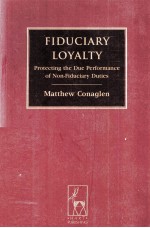

FIDUCIARY LOYALTY PROTECTING THE DUE PERFORMANCE OF NON-FIDUCIARY DUTIESPDF电子书下载
- 电子书积分:11 积分如何计算积分?
- 作 者:MATTHEW CONAGLEN
- 出 版 社:OREGON
- 出版年份:2011
- ISBN:1849462143
- 页数:287 页
Chapter 1 Prologue 1
Chapter 2 Points of Departure 7
Chapter 3 Peculiarly Fiduciary Duties 32
Chapter 4 Fiduciary Loyalty 59
Chapter 5 Fiduciary Doctrine and Morality 106
Chapter 6 Conflicts between Inconsistent Duties 142
Chapter 7 Implications 177
Chapter 8 Conceptual Affinities 214
Chapter 9 The Incidence of Fiduciary Duties 245
Chapter 10 Epilogue 269
Index 277
1 Prologue 1
2 Points of Departure 7
Ⅰ.Form of Analysis 7
Ⅱ.Subject Matter of Analysis 11
A. Historical Analogies 11
B. Modern Approach 16
i. Genesis and Gestation 16
ii. Justification 18
3 Peculiarly Fiduciary Duties 32
Ⅰ. Duty to Perform the Task Undertaken 32
Ⅱ. Duties of Care and Skill 35
Ⅲ. Conflict and Profit Principles 39
Ⅳ. Good Faith 40
Ⅴ. Proper Purposes Doctrine 44
Ⅵ. Fiduciary Powers 50
Ⅶ. Duty to Act in Good Faith in the Principal’s Best Interests 54
4 Fiduciary Loyalty 59
Ⅰ. Introduction 59
Ⅱ. Subsidiary Prophylactic Protection 61
A. Protective Function 62
B. Prophylaxis 67
C. Subsidiarity 75
Ⅲ. Remedies 76
A. Rescission and Profit-Stripping 76
i. Rescission 76
ii. Accounts of Profits and Constructive Trusts 79
iii. Connection with Fiduciary Protection 80
B. Compensation for Loss 85
i. Availability 85
ii. Causation and Loss 90
iii. Connection with Fiduciary Protection 94
Ⅳ. Critics 97
5 Fiduciary Doctrine and Morality 106
Ⅰ. General Observations 107
Ⅱ. The Argument from History 109
Ⅲ. The Profit Principle 113
A. Existence of the Profit Principle 114
B. Relationship to the Conflict Principle 120
Ⅳ. The Fair-Dealing Rule 125
A. The Self-Dealing Rule 126
B. The Fair-Dealing Rule 128
i. References to ‘Fairness’ 129
ii. Non-Critical Relevance of‘Fairness’ 130
iii. Fairness as Evidence of Full Disclosure 135
iv. Relationship to the Self-Dealing Rule and Conflict Principle 138
Ⅴ. The Corporate Opportunity Doctrine 139
6 Conflicts between Inconsistent Duties 142
Ⅰ. Origins 143
Ⅱ. Content and Function 146
A. Potential Conflicts 147
B. Actual Conflicts 149
C. Inhibition 150
i. Pattern of Liability 152
ii. Function 153
Ⅲ. Remedies 158
A. Stopping Further Action 158
B. Rescission of Resultant Transaction 159
C. Forfeiture of Fees and Other Profits 161
i. Fees Paid by the Non-claimant Principal 161
ii. Fees Paid by the Claimant Principal 162
D. Equitable Compensation 164
i. Availability and Function 164
ii. Identifying Loss 165
iii. Contributory Fault 172
7 Implications 177
Ⅰ. Scope of Fiduciary Duties 177
Ⅱ. The Vital Nature of Non-fiduciary Duties 185
A. Consequence of the Protective Function 185
B. Potential Counter-examples 188
i. Preventing Circumvention of Fiduciary Protection 188
ii. Solicitors Cases 190
iii. Negotiations towards Joint Ventures 195
iv. Bare Trusts 197
Ⅲ. Proscriptive Duties 201
Ⅳ. Authorisation 204
Ⅴ. Critiques of Fiduciary Doctrine 208
8 Conceptual Affinities 214
Ⅰ. Contract and Fiduciary Doctrine 214
Ⅱ. Torts and Fiduciary Doctrine 221
A. Fiduciary Doctrine and Negligence 222
B. Surrogacy for Tort Law Generally 228
i. Cause of Action Surrogacy 228
ii. Civil Wrongs 229
Ⅲ. Undue Influence and Confidence 236
A. Undue Influence 236
B. Confidence 241
9 The Incidence of Fiduciary Duties 245
Ⅰ. Academic Commentators 246
A. Acting on Behalf of Another 246
B. Discretion and Power 247
C. Reasonable Expectations 249
D. Limited Access 251
Ⅱ. Turning Theory into Practice 254
A. Judicial Applications 254
B. Relevant Considerations 260
10 Epilogue 269
Index 277
- 《统整多元智慧与学习风格 把每位学生带上来》HARVEY F. SILVER ,RICHARD W .STRONG & MATTHEW J .PERINI著;田耐情博士译 2002
- 《校长教学领导:理论与应用》Matthew Militello,Sharon F.Rallis,& Ellen B.Goldring著;林新发校阅;谢传崇译 2011
- 《末日战争:终局之局》马修·葛拉斯(MATTHEW GLASS)著;李斯毅译 2012
- 《MCSE:NT Server 4学习指南》(美)(M.施特雷贝)Matthew Strebe等著;孙卫国等译 1998
- 《SQL Server 7 24学时教程》(美)谢普克(Matthew Shepker)著;刘艺,周增改译 2000
- 《直销规划与执行》(英)布赖恩·托马斯(Brian Thomas),(英)马修·豪斯顿(Matthew Housden)著;杨波,彭思立,黄锐译 2005
- 《考古学理论导论》马修·约翰逊(Matthew Johnson)著;魏峻译 2005
- 《虚拟化技术入门实战 第2版》(美)Matthew Portnoy著;杜静,敖富江,李博译 2017
- 《从创意到创业 写给创业者的指导手册》(德)马修·莫克里奇(Matthew Mockridge)著 2017
- 《英格兰普通法史》(英)马修·黑尔(Matthew Hale)著 2017
